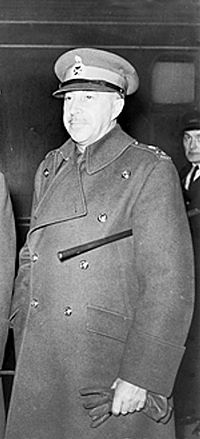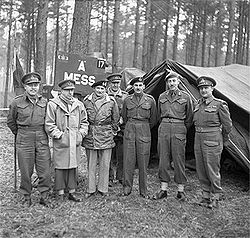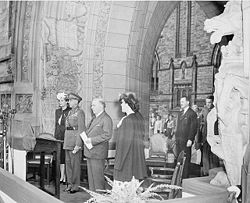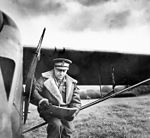- Harry Crerar
-
Henry Duncan Graham (Harry) Crerar 
General The Honourable Henry Duncan Graham (Harry) CrerarBorn April 28, 1888
Hamilton, OntarioDied April 1, 1965 (aged 76)
Ottawa, OntarioBuried at Beechwood Cemetery
Ottawa, OntarioAllegiance Canada Service/branch Canadian Army Years of service 1910 - 1946 Rank General Commands held Director of Military Operations & Military Intelligence (1935 - 1938)
First Canadian Army (1944 - 1946)
Commandant of Royal Military College of Canada (1938 - 1939)
Chief of General Staff, National Defence Headquarters (1940 - 1941)
2nd Canadian Infantry Division (1941 - 1942)
I Canadian Corps (1942 - 1944)Battles/wars World War I
World War IIAwards Order of the Companions of Honour
Companion of the Order of the Bath
Distinguished Service Order
Knight of the Venerable Order of Saint John
Canadian Forces DecorationOther work Aide-de-Camp General to the King (1948 - 1951)
Aide-de-Camp General to the Queen (1952)
Queen's Privy Council for Canada (June 25, 1964)Henry Duncan Graham "Harry" Crerar CH, CB, DSO, KStJ, CD, PC (April 28, 1888 – April 1, 1965) was a Canadian general and the country's "leading field commander" in World War II.
Contents
Early years
Harry was born in Hamilton, Ontario to lawyer Peter Crerar and Marion Stinson and died in Ottawa, Ontario. Prior to his military service, he worked as an engineer with the Hydro-Electric Power Commission of Ontario, where he founded the research department in 1912. He attended and graduated from Upper Canada College and Highfield School in Hamilton in 1906, and then went to the Royal Military College of Canada, in Kingston, Ontario graduating in 1910. He rose to the rank of lieutenant-colonel of artillery in World War I. Unlike most officers, he remained in the army after the war.[1] He was appointed Director of Military Operations & Military Intelligence in 1935 and Commandant of the Royal Military College of Canada in 1938.[2]
World War II
He served in World War II, initially as a Brigadier on the General Staff at Canadian Military Headquarters in England. In early 1940 he was appointed Vice Chief General Staff in Canada and then later that year he became Chief of the General Staff.[2]
He became General Officer Commanding 2nd Canadian Infantry Division in England in 1941, General Officer Commanding I Canadian Corps in England and then Italy in 1942 and General Officer Commanding 1st Canadian Army in North-West Europe in 1944.[2] Crerar was recovering from a bout of dysentery during the Battle of the Scheldt in October 1944 and his role as General Officer Commanding was assumed by Lieutenant-General Guy Simonds.
Crerar was on the September 18, 1944 cover of Time magazine. He was promoted to full general in November 1944.
He has been described as an able administrator and politically astute, assessments of his performance as a military commander range from "mediocre" to "competent".[3]
Farewell
A Farewell sign posted on behalf of Gen. H.D.G. Crerar to troops of the 1st Canadian Army departing from Holland in 1945
'Here's wishing you a satisfactory and speedy journey home, and that you find happiness at the end of it. You go back with your share of the magnificent reputation earned by the Canadians in every operation in which they have participated in this war. A fine reputation is a possession beyond price. Maintain it - for the sake of all of us, past and present - in the days ahead. I know that you will get a great welcome on your return. See to it that those Canadian units and drafts which follow after you get just as good a 'welcome home' when they also get back. Good luck to each one of you - and thanks for everything. (H.D.G. Crerar) General'[4]Post-war
Crerar returned to Ottawa on 7 August 1945 after World War II. Crerar retired from the army in 1946 and later occupied diplomatic postings in Czechoslovakia, the Netherlands and Japan.
He believed that the Canadian Red Ensign should remain the national flag of Canada.[5]
Crerar was sworn into the Queen's Privy Council for Canada on June 25, 1964.
Tribute
The Crerar neighbourhood on the Hamilton, Ontario mountain is named after him. It is bounded by the Lincoln M. Alexander Parkway (north), Stone Church Road East (south), Upper Wellington Street (west) and Upper Wentworth Street (east). Landmarks in this neighbourhood include Ebenezer Villa (retirement home) and Crerar Park, also named after him. In Ottawa, Ontario a road is named after him that connects to Merivale Road, a major road in the city. Crerar Street in Regina is also named in his honour.
A boulevard in the city of Kingston, Ontario is also named in his honour. Crerar Boulevard runs south from Front Road in the Point Pleasant district, near Reddendale. The tree-lined street is bounded by Bishop Street to the East and Lakeview Avenue/Gordon Street to the West.
References
- ^ Harry Crerar Canada Veterans of Valour
- ^ a b c Harry Crerar at Generals.dk
- ^ Henry Duncan Graham Crerar The Columbia Encyclopedia, Sixth Edition, 2008
- ^ Farewell sign
- ^ Canadian House of Commons Debates, 17 June 1964.
Further reading
- 4237 Dr. Adrian Preston & Peter Dennis (Edited) "Swords and Covenants" Rowman And Littlefield, London. Croom Helm. 1976.
- H16511 Dr. Richard Arthur Preston "To Serve Canada: A History of the Royal Military College of Canada" 1997 Toronto, University of Toronto Press, 1969.
- H16511 Dr. Richard Arthur Preston "Canada's RMC - A History of Royal Military College" Second Edition 1982
- H16511 Dr. Richard Preston "R.M.C. and Kingston: The effect of imperial and military influences on a Canadian community" 1968 Kingston, Ontario.
- H1877 R. Guy C. Smith (editor) "As You Were! Ex-Cadets Remember". In 2 Volumes. Volume I: 1876-1918. Volume II: 1919-1984. RMC. Kingston, Ontario. The R.M.C. Club of Canada. 1984
- MapArt Golden Horseshoe Atlas - Page 657 - Grids M13, M14
- J.L. Granatstein. The Generals : the Canadian Army's Senior Commanders in the Second World War (Toronto, 1993). ISBN 0-7737-5728-7
- Hillfield-Strathallan College celebrates 100 years, The Spectator. Hamilton, Ont.: Sep 8, 2001. pg. A.08
- Juno Beach Centre - General H.D.G. Crerar
Military offices Preceded by
Thomas Victor AndersonChief of the General Staff
1940-1941Succeeded by
Kenneth StuartGeneral Officers Commanding Edward Selby Smyth • Richard Luard • Frederick Dobson Middleton • Ivor Herbert • William Julius Gascoigne • Edward Hutton • Richard Hebden O'Grady Haly • Earl of Dundonald
Chiefs of the General Staff Percy Lake • William Otter • Colin Mackenzie • Willoughby Gwatkin • James MacBrien • Herbert Thacker • Andrew McNaughton • Ernest Ashton • Thomas Anderson • Harry Crerar • Kenneth Stuart • John Murchie • Charles Foulkes • Guy Simonds • Howard Graham • Samuel Clark • Geoffrey Walsh
Commanders, Mobile Command Jean Victor Allard • William Anderson • Gilles Turcot • William Milroy • Stanley Waters • Jacques Chouinard • Jean Jacques Paradis • Charles Belzile • James Fox • Kent Foster • Jim Gervais
Chiefs of the Land Staff Gord Reay • Maurice Baril • William Leach • Mike Jeffery • Rick Hillier • Marc Caron • Andrew Leslie • Peter Devlin
Categories:- 1888 births
- 1965 deaths
- Canadian Anglicans
- Canadian diplomats
- Canadian generals
- Recipients of the Canadian Forces Decoration
- Members of the Order of the Companions of Honour
- Members of the Queen's Privy Council for Canada
- Companions of the Order of the Bath
- Knights of the Order of St John
- Companions of the Distinguished Service Order
- Canadian military personnel of World War I
- Canadian military personnel of World War II
- Operation Overlord people
- People from Hamilton, Ontario
- Canadian people of Scottish descent
- Upper Canada College alumni
- Royal Military College of Canada people
- Graduates of the Staff College, Camberley
Wikimedia Foundation. 2010.




